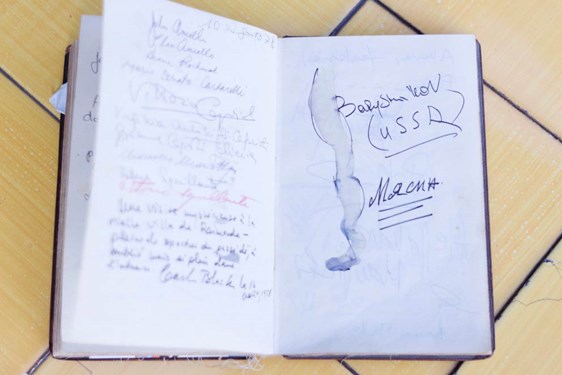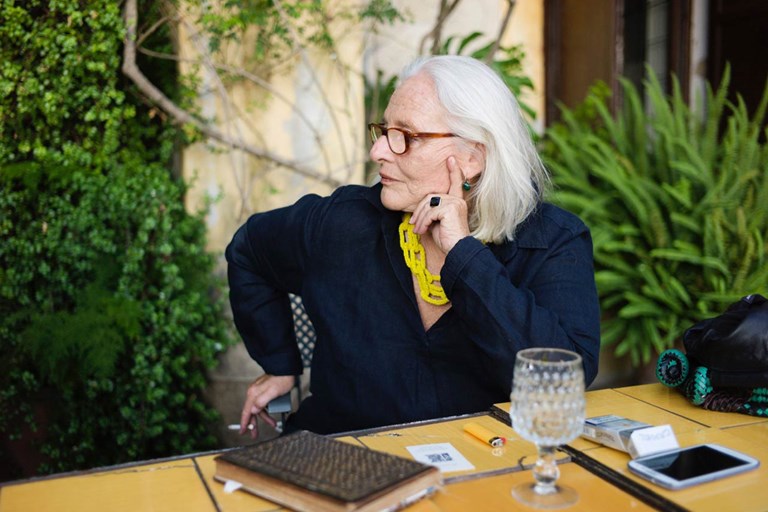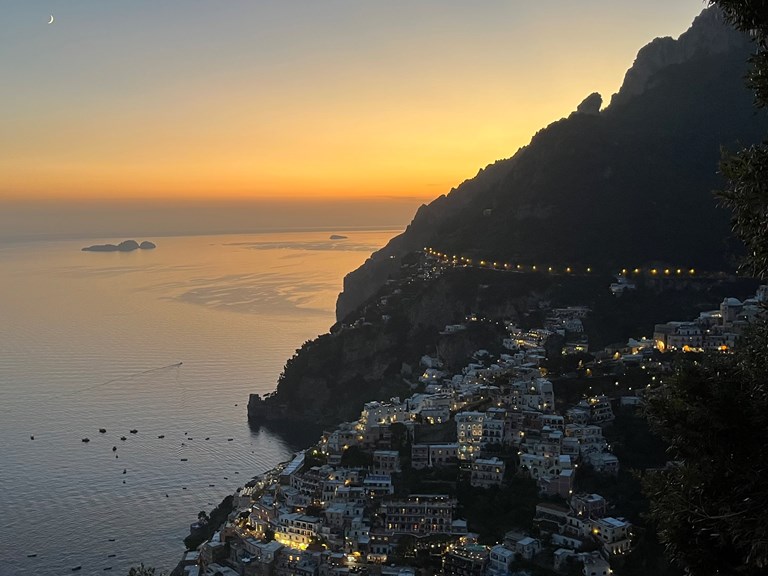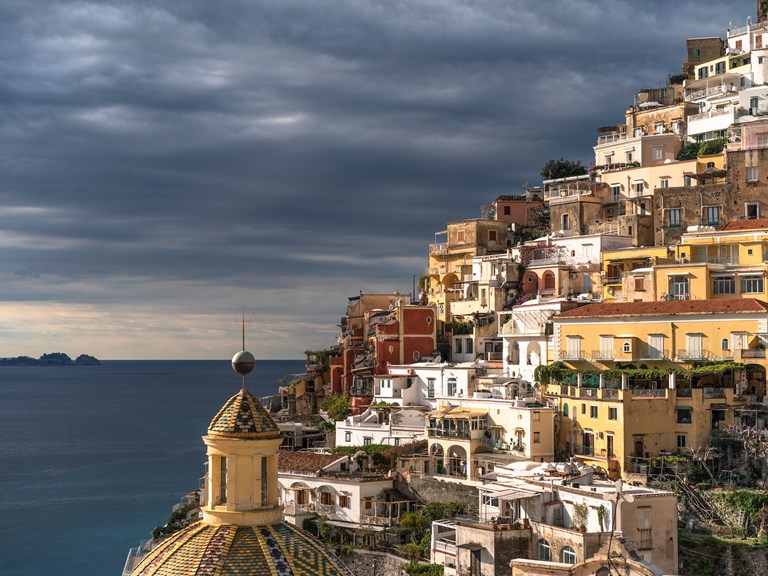POSITANESI: RAIMONDA GAETANI
04.11.2015 POSITANO
As she leafs through the pages, signed by those who have come to stay over the years, the artist, costume and set designer, whose film work has included collaborations with Franco Zeffirelli and Federico Fellini, keeps up a running commentary, jumping from name to name so quickly there’s no time for foolish questions like “What, you mean the Laurence Olivier?”
“Look, there’s Kim Fraser… he once ran up the steps to Nocelle playing the bagpipes… and here’s Mikhail Baryshnikov, who had just left Russia – he drew this fantastic ballet dancer’s leg. And there’s Laurence Olivier, and Joan Plowright. Olivier rather pompously scribbled an olive-tree heraldic crest next to his signature, and on the next page… look… Eduardo de Filippo replied with this heraldic pigeon… and here’s Lenny Bernstein, who wrote “to my favourite wrestling partner of all time, or at least to my favourite female wrestling partner of all time, who I love very much”…”

View
The entries in the book go back as far as the 1920s. The house itself was bought in 1905 by Raimonda’s grandparents, together with the watchtower that stands on the other side of the road, and the surrounding steeply terraced land where Le Sirenuse’s vegetable garden and olive groves are located. Inside, family heirloom furniture, old photographs, paintings by Raimonda and other artists, and costumes and theatrical props spanning a forty-year career are arranged with elegant nonchalance in a grand bohemian house which is one of the last testimonies of a time before Positano was discovered by mass tourism.
Raimonda’s grandmother Luisa, a German artist, was drawn to Positano by its “oriental” cachet, its shimmering cupolas and hidden lanes, so different from cheerful, undemanding Sorrento. Luisa’s husband, Giovanni Alfredo Pattison, was born in Naples to the son of a British engineer from Newcastle, who in 1866 had established the city’s leading heavy engineering firm, C. & T. T. Pattison, which made everything from locomotives to railway tunnel drilling machines to Naples’ first gas-lit street lamps. But by the time Giovanni Alfredo became the co-owner and manager of the company in 1899 its main business was shipbuilding; it had become one of the leading suppliers of the Italian navy, for whom it supplied battleships, torpedo boats and other bits of military hardware.
Positano was where Giovanni Alfredo went to get away from his demanding work schedule and social life in Naples. As well as the house and land, he and Luisa bought up what was then Positano’s only hotel, the Pensione Margherita. This was well before the ‘Nastro Azzurro’ road was completed – so they would drive their Mercedes as far as Colli di San Pietro where a carriage would meet them and take them down the unpaved coast road to Positano.
When, at the end of the 1920s, a merger ousted Giovanni Alfredo from the presidency of the company he had helped to create, he and Luisa were able to spend more time in the house which they saw as their refuge. Between 1940 and 1943, the Fascist authorities prevented the family from leaving Positano, as Giovanni Alfredo – who had never renounced his British citizenship – was regarded with some suspicion despite his firm’s contribution to the Italian war effort.
By this time the couple’s only child, Raimonda’s mother Nora – something of a tomboy, with a penchant for driving racing cars along narrow Amalfi Coast roads – had married Neapolitan aristocrat Count Roberto Gaetani. The war years may have been tough, but Raimonda says that her mother remembered them as “among the happiest years of her life”. Born in 1942, Raimonda herself grew up in a Positano that was a magnet for painters, writers, and people from the theatre and cinema worlds. “It was cheap to rent houses here back then”, she recalls, “and there was an artist’s community even through winter… once even Rothko turned up, to teach at a workshop set up by two mad Americans”.
As a child, Raimonda used to spend her summer holidays here, spending much of her time on the private beach below the family watchtower. Later, when she was studying architecture in Naples, she met another summer resident, film, theatre and opera director Franco Zeffirelli. “I used to dress quite extravagantly”, Raimonda explains, “and one day in 1973, just like that, Zeffirelli asked me if I’d do the costumes for a production of Eduardo de Filippo’s play Saturday Sunday Monday that he was putting on at London’s National Theatre. I said yes, of course… so it turned out that the first actor I dressed in my career was Laurence Olivier. I always started with the feet – like all Neapolitans, I figured that if I got the shoes right the rest would follow”.
Opera and ballet were later added to her roster, with Raimonda designing costumes for Placido Domingo and the rest of the cast in Zeffirelli’s 1992 stagings of I Pagliacci in Rome, Los Angeles and Washington, the first of several golden-age Italian operas that she would work on. She also dressed legendary Italian ballerina Carla Fracci in three productions directed by the latter’s husband, Beppe Menegatti. Forays into cinema included helping Danilo Donati design the gloriously outlandish, Oscar-winning costumes for Casanova, Federico Fellini’s caustic account of the famous Venetian lover’s twilight years.
Asked whether she believes that the golden years of the town’s cultural whirl are over, Gaetani points to the case of her nephew, novelist and scriptwriter Niccolò Ammanniti (I’m Not Scared, As God Commands), who grew up in Positano and represents a later, post-Zeffirelli generation of artists who were nurtured here. “Culture in Positano is always evolving”, says Gaetani, “and taking different forms – there’s probably some young kid growing up here right now who will go on to represent the next generation”.
Photo © Roberto Salomone
Le Sirenuse Newsletter
Stay up to date
Sign up to our newsletter for regular updates on Amalfi Coast stories, events, recipes and glorious sunsets


